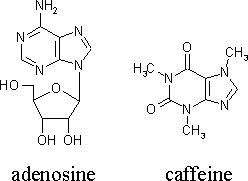Introduction | What is Caffeine: Molecule Structure | Stimulating Science: The Properties of Caffeine | Discovery: The Magical Bean | Coffee Creates a Social Lifestyle in Europe |Colonization and Coffee|Coffee’s Impact on the Nation of Brazil|Coffee Industry Today| Conclusions
Caffeine is a psychoactive drug that is believed to be one of the most commonly used drugs around the world. After one ingests caffeine, it enters the bloodstream within ten minutes, and remains in one’s body for around twelve hours. “Caffeine has powerful psychological effects on humans and animals. It stimulates heart muscles and relaxes certain structures that contain smooth muscle, including the coronary arteries and bronchi. It is also a diuretic” (Smith, 2004, p 153).
It is also a central nervous system stimulant. Caffeine blocks the effect of the molecule adenosine in the brain, as well as in other areas of the body. Adenosine, as described in Napoleon’s Button’s is “a neuromodulator, a molecule that decreases the rate of spontaneous nerve firing and thus slows the release of other neurotransmitters; therefore can induce sleep” (Le Couteur & Burreson, 2003, p 261). Caffeine interferes with this process by binding to the adenosine receptors in the nerves, and therefore, the effects of adenosine that render one tired or sleepy cannot take place. Adenosine receptors are not only located in the brain, and can be found in other parts of the body. When caffeine molecules occupy these receptors, one will experience a “caffeine buzz” – which consists of increased heart rate, and the constriction or opening of blood vessels. (Le Couteur, 2003, p 261). One can observe below the similarities of the structures of adenosine and caffeine.

